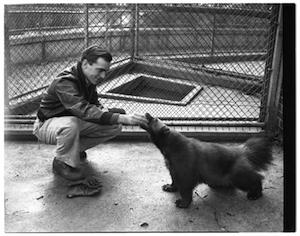The University of Michigan Zoo
by oldnews
If you were in Ann Arbor between 1929 and 1962, you had the opportunity to visit the University of Michigan Zoo. On October 11, 1929, an article in the Michigan Daily said the zoo would open “in about three weeks” and would boast a weather vane by famed UM sculptor Carleton Angell. A December 11, 1929 Michigan Daily article reports animals moved in "last week". The tiny zoo enclosure was constructed behind the Alexander G. Ruthven Museums Building, what most of us think of as U of M's Natural History Museum. (The giant pumas that guard the front doors of the Natural History Museum were sculpted by Carleton Angell too!)
Inside today's museum is a memorial to the zoo which explains "...In 1929, a University of Michigan alumnus anonymously offered a collection of live native Michigan animals. It was the donor's hope that the animals could be enjoyed by children staying in the hospital then located across the street. A circular animal house and pond known as the "Museum Zoological Park" were constructed behind the Museums Building." Old news articles and photos show zoo residents like badgers, a bobcat, red foxes, skunks, otters, raccoons, several pairs of black bears throughout the years, and a wolverine named Biff. At some point a "reptile pit" was added, which included snakes and turtles.
In 1938, elaborate plans surfaced for a forty acre zoological garden to be located near the University of Michigan hospital. A WPA grant was "expected to provide the finances" for a wildlife utopia, where animals of the tiny U of M Zoo would be turned loose to live with no cages. The location of this dream zoo, which never came to fruition, seems to be the edge of what is now Nichols Arboretum.
Despite the popularity of the U of M Zoo, it was torn down in 1962 to make room for an addition to the Ruthven Museums Building. A few Ann Arbor City Council members, as well as many Ann Arbor townspeople, appealed to the University Board of Regents to save and/or relocate the beloved 30something year old zoo, but eventually the animals were relocated and the zoo became a memory. By today's zoological standards, the animals of Ann Arbor lived in fairly terrible, tiny, cramped quarters. The "Animal House", as it came to be called, never grew to be a wildlife utopia, but certainly provided countless Ann Arbor children and their families the opportunity to appreciate Michigan wildlife up close.
Blog Post

Comments
I wish the Natural History
I wish the Natural History Museum celebrated this more, I've been in there many times and never new about the zoo until this article!
That's what I thought too.
That's what I thought too.
While I'm glad that the
While I'm glad that the animals were relocated to hopefully better living quarters, I do wish there were something like this in Ann Arbor that was easy to get too and accessible even for folks, but especially children, with disabilities. Kids in wheelchairs often have a hard time seeing the animals at places like the zoo because the barrier fences are just about at their eye level or there are plants at their eye level.
There was certainly more than
There was certainly more than one pair of bears. I wonder if they all had the same names. The bears who liked the apples I brought to the zoo were "Mazie," and "Blue." A later Ann Arbor News story reported that they came to an even more dismal end in a roadside zoo up north. The reptile pit won immortality in a mystery novel ("The Dark Tunnel"?) in which the hero, making his escape from something or other, leaps over a low wall (it was, in fact, very low) and landed in a shallow pond with the frogs, turtles and local snakes.
The Creature Conservancy and
The Creature Conservancy and Leslie Science Center have some critters. Not really a zoo, but cool nonetheless.
TBB
Interesting!
Interesting!
I grew up up on Geddes and…
I grew up up on Geddes and we used to visit the 'zoo' every time we went to the museum (where I invariably had to sit on the pumas out front). Sometime during elementary school it disappeared and though I agree that it wasn't ideal living conditions for the animals I missed it. Like the gila monsters they had on display in the museum, and the pumas themselves, the zoo and its inhabitants lives in my fondest childhood memories.